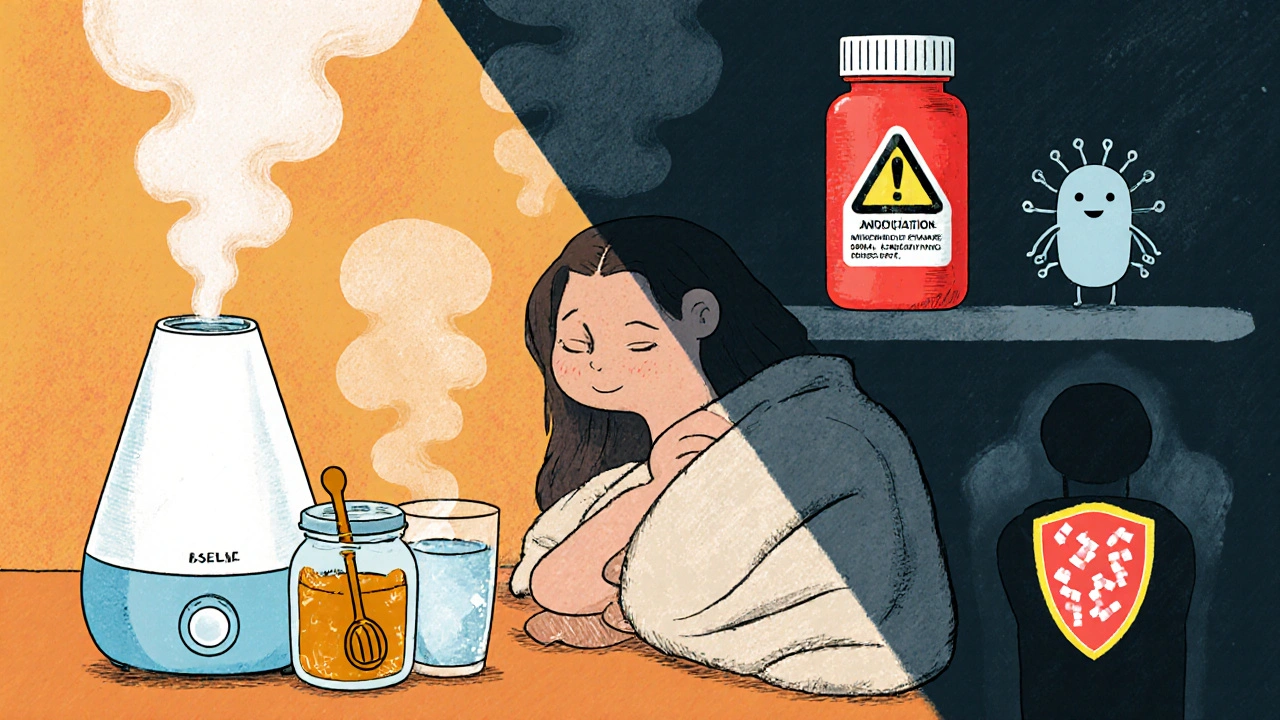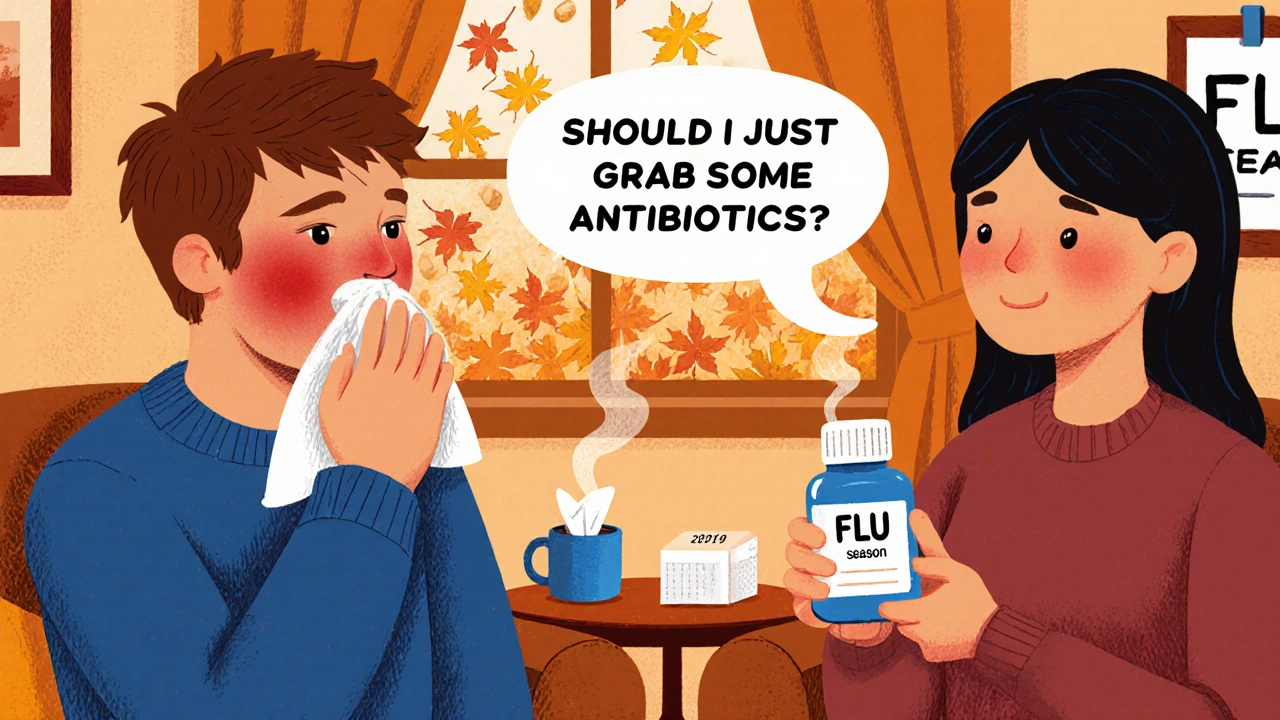Bronchitis Antibiotic Decision Guide
Assess your bronchitis symptoms
This tool helps you understand if antibiotics might be appropriate based on clinical guidelines. Remember, only a doctor can prescribe antibiotics.
Important Information
This tool is for informational purposes only and does not replace professional medical advice. Only a doctor can prescribe antibiotics. Please consult your healthcare provider for proper diagnosis and treatment.
Every autumn I hear a friend complain, “My cough won’t quit, should I just grab a round of pills?” The quick answer is rarely that simple. In the United States alone, doctors prescribe antibiotics for bronchitis about 70% of the time, even though most cases are viral and won’t benefit from a drug that kills bacteria. bronchitis antibiotics become useful only when the infection is truly bacterial or complications are looming.
What Exactly Is Bronchitis?
Bronchitis is a inflammation of the bronchial tubes, the airways that carry air to and from the lungs. The condition can be acute (lasting a few weeks) or chronic (persisting for months or years, often linked to smoking). Acute bronchitis usually follows a cold or flu, while chronic bronchitis is a form of chronic obstructive pulmonary disease (COPD).
Why Do Antibiotics Get Mentioned So Often?
“Antibiotics” instantly conjure the image of a cure‑all, but they only work against bacterial infections, not viruses. When a patient presents a barking cough, fever, and shortness of breath, the instinct is to reach for a prescription, yet studies from the NHS and CDC show that fewer than 10% of acute bronchitis cases have a bacterial cause.
Distinguishing Viral From Bacterial Bronchitis
Understanding the difference saves both the patient’s gut flora and the healthcare system’s pocket. Below is a quick comparison:
| Feature | Viral Bronchitis | Bacterial Bronchitis |
|---|---|---|
| Usual Cause | Rhinovirus, influenza, RSV | Streptococcus pneumoniae, Haemophilus influenzae, Mycoplasma pneumoniae |
| Fever | Often low‑grade or absent | Higher, >38.5°C (101.3°F) common |
| Cough Duration | 10‑14days, then improves | Persisting >2weeks or worsening after 5‑7days |
| Chest X‑ray | Usually normal | May show infiltrates or lobar consolidation |
| CRP Test | Low or mildly elevated (<20mg/L) | Elevated (>50mg/L) indicating bacterial inflammation |
| Antibiotic Needed? | No | Yes, if bacteria confirmed or strong suspicion |
| First‑Line Antibiotic | N/A | Amoxicillin or Azithromycin for atypical pathogens |
How Clinicians Decide Whether to Prescribe
Doctors follow a step‑by‑step assessment that mixes history, physical exam, and selective testing. Here’s a typical workflow:
- Ask about symptom onset, fever pattern, and any recent viral illness.
- Listen to the lungs: crackles may hint at bacterial pneumonia rather than simple bronchitis.
- Order a Chest X‑ray only if there are red‑flag signs (high fever, tachycardia, shortness of breath).
- Consider a CRP test (C‑reactive protein) to gauge inflammation level. A result >50mg/L pushes the decision toward antibiotics.
- If bacterial infection is likely, choose an antibiotic based on local resistance patterns - usually Amoxicillin for typical bacteria, or Azithromycin for atypical organisms.
When Antibiotics Are Really Needed
Here are the three most common scenarios that merit a prescription:
- Confirmed bacterial bronchitis: sputum culture or rapid antigen test identifies a pathogen.
- Complicated bronchitis: development of secondary pneumonia, especially in older adults or those with chronic lung disease.
- High‑risk patients: immunocompromised individuals, people with severe COPD, or those with a history of repeat hospitalizations.
In all other cases, the best approach is supportive care: rest, hydration, and possibly a short‑acting bronchodilator for wheezing.
Supportive Measures That Help Without Antibiotics
Even when antibiotics are off the table, you can ease symptoms and speed recovery:
- Fluids: thin mucus and keep the airway moist.
- Humidified air: a cool‑mist humidifier or a steamy shower reduces irritation.
- Honey (for adults and children over one year): a spoonful a few times a day can soothe a cough.
- Over‑the‑counter (OTC) cough suppressants:
- Dextromethorphan for dry cough.
- Guaifenesin for productive cough to loosen phlegm.
- Bronchodilators (e.g., short‑acting albuterol) for wheeze or shortness of breath.
Risks of Unnecessary Antibiotic Use
Overprescribing isn’t harmless. The side‑effects range from mild (upset stomach, rash) to severe (Clostridioides difficile infection). Moreover, each unnecessary course nudges bacteria toward resistance, making future infections harder to treat. The WHO estimates that antimicrobial resistance could cause 10million deaths per year by 2050 if trends continue.

What Do Guidelines Say?
Both the UK’s National Institute for Health and Care Excellence (NICE) and the US Infectious Diseases Society (IDSA) agree on a conservative stance:
- Do not prescribe antibiotics for uncomplicated acute bronchitis in otherwise healthy adults.
- Use CRP testing or rapid viral panels where available to guide the decision.
- Reserve antibiotics for patients with clear bacterial signs, worsening symptoms, or high‑risk comorbidities.
Sticking to these recommendations reduces unnecessary drug exposure while keeping patients safe.
Frequently Asked Questions
Frequently Asked Questions
Can a cough lasting more than two weeks indicate a need for antibiotics?
A lingering cough alone isn’t enough. If it’s dry, without fever, and you have a normal chest X‑ray, antibiotics are unlikely to help. Look for fever, worsening sputum, or shortness of breath before considering medicines.
Is it ever safe to take an over‑the‑counter antibiotic for bronchitis?
No. OTC products that claim to be “antibiotic” are usually herbal or zinc‑based and have no proven effect on bacteria. If a doctor prescribes a real antibiotic, follow the dosage exactly.
How long should I take antibiotics if they’re prescribed?
Typical courses for bronchitis are 5‑7days of amoxicillin or a single 3‑day dose of azithromycin. Longer courses increase side‑effects and resistance risk.
What home test can tell me if my bronchitis is viral?
Rapid antigen tests for flu or RSV can be done at pharmacies. A negative result plus low CRP (<20mg/L) strongly points to a viral cause.
Should smokers with bronchitis automatically get antibiotics?
Not automatically. Smoking irritates the airways, making coughs last longer, but antibiotics are only indicated if a bacterial infection is documented.
Putting It All Together: A Quick Decision Checklist
- Did the patient have a fever >38.5°C? - Yes → consider bacterial cause.
- Is CRP >50mg/L? - Yes → antibiotics likely beneficial.
- Are there red‑flag signs (shortness of breath, chest pain, rapid heart rate)? - Yes → get a chest X‑ray and possibly start antibiotics.
- Is the patient high‑risk (elderly, COPD, immunocompromised)? - Yes → lower threshold for prescribing.
- Otherwise, focus on supportive care and re‑evaluate in 3‑5days.
By following this framework, you’ll avoid the common trap of reaching for antibiotics every time a cough lingers, while still protecting those who truly need them.


Natala Storczyk
Rise up against the medical bureaucracy!!! They want you swallowing antibiotics for a simple cough while the nation bleeds from over‑prescription!!! Demand evidence, demand restraint, demand YOUR health, not the pharma’s profit!!!
Wyatt Schwindt
The guidelines are clear and help avoid unnecessary meds.
Sarah Hanson
According to the latest evidence, antibiotics are indicated only when bacterial infection is confirmed; otherwise supportive care suffices. Definately follow the protocol.
Lyle Mills
Clinical decision‑making integrates CRP thresholds and radiographic findings to differentiate viral from bacterial etiologies.
Nhasala Joshi
🚨 Wake up! The pharma elite are hiding the truth about over‑use of antibiotics. They seed fake “guidelines” to keep us dependent. Trust the data, not the agenda! 😱💊
Barbara Grzegorzewska
Honestly, the lay public thinks every cough warrants a prescription. It's a simplistic narrative, utterly divorced from the nuanced pathophysiology we, the educated elite, understand. Stop the hype!